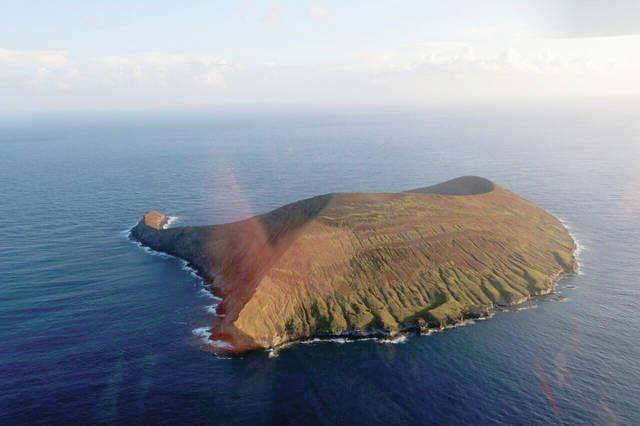WAIMEA — Questions about the Lehua Island rat eradication and restoration project were rampant at a Tuesday meeting in Waimea. But it probably doesn’t matter. Concerns voiced at the meeting might not have an impact on the project because the
WAIMEA — Questions about the Lehua Island rat eradication and restoration project were rampant at a Tuesday meeting in Waimea.
But it probably doesn’t matter.
Concerns voiced at the meeting might not have an impact on the project because the last comment period on the draft Environmental Assessment ended in May, according to the Department of Land and Natural Resources.
In total, the state’s Division of Forestry and Wildlife received 25 comments on the state and federal EAs. The plan is to drop about 10 tons of diphacinone pellets from helicopters over the island over three days next month — on Aug. 8, Aug. 18 and Aug. 29, pending the approval of three permits.
Those permits are an aerial application permit, a National Oceanic and Atmospheric Administration section 7 letter of concurrence, and a Migratory Bird Treat Act permit.
The purpose of Tuesday’s meeting was to provide the community with a summary of responses to comments and of information in the final Environmental Assessment, DOFAW representatives said in a statement to TGI on Wednesday.
However, the team hosting Tuesday’s meeting didn’t get through the presentation. Most of the meeting was spent taking questions about the project.
Turning Lehua Island into a refuge for birds and reintroducing native Hawaiian plants to the island is a good idea, said Rep. Dee Morikawa, but she said she also has concerns.
“We (Kauai legislators) were briefed about this project earlier this year and I felt that this eradication was necessary,” she said. “After (Tuesday’s) meeting, I have a lot of questions.”
She continued: “The state agencies involved in this project need to stop and listen to the people. Yes, we want to save the birds, but we also want to save our marine life, coral and ourselves.”
Impacts to the marine environment, endangered animals and fishing were among concerns voiced at the meeting.
Robert Cremer Jr. of Kapaa asked for a total number of rats on the island and documentation of those rats’ impacts on Lehua’s birds.
Andre Raine of the Kauai Endangered Seabird Recovery Project explained the rats are widespread across the island.
Their exact numbers are inconsequential to the project because their presence is everywhere, he explained.
Cremer also wanted to know why rat eradication and control on Lehua couldn’t be done by trapping instead of dropping poison.
“I know we have to poison the rats, but it has to be contained,” Cremer said.
Crumbly and steep terrain provides dangerous conditions for people, DOFAW representatives said in a Wednesday statement.
The cost to use human labor for rat eradication would be several million dollars more than the current estimated $1 million cost, according to DOFAW.
Terry Lilley of Hanalei pointed out Hawaiian monk seals and other endangered species spend time near Lehua Island and questioned whether the project would impact the animals.
He said the state is missing an endangered species study and a Habitat Conservation Plan in order to move forward with the project.
“I’m just asking you to follow your own rules,” Lilley said. “Bring back a little science before you do these crazy-ass projects. Not nearly enough studies have been done.”
But DOFAW officials pointed to hundreds of rodent eradication projects done throughout the world and tests on seawater, crabs, fish and opihi when diphacinone was used to eradicate rats from Mokapu Island in 2008, and when an attempt was made on Lehua in 2009.
They also highlighted DOFAW’s final EAs with a finding of no significant impact to the environment, including endangered species.
And with a finding of no significant impact, they don’t need an HCP, representatives said.
“Given that the terrestrial endangered species are extremely rare on or around Lehua, the potential for take of them is extremely low,” the statement said. “Also, the kind of bait being proposed, the temporary nature of its use and the time of year chosen to do this operation mitigate for impacts on threatened and endangered species by avoiding times when they are known to actively use places like Lehua.”


